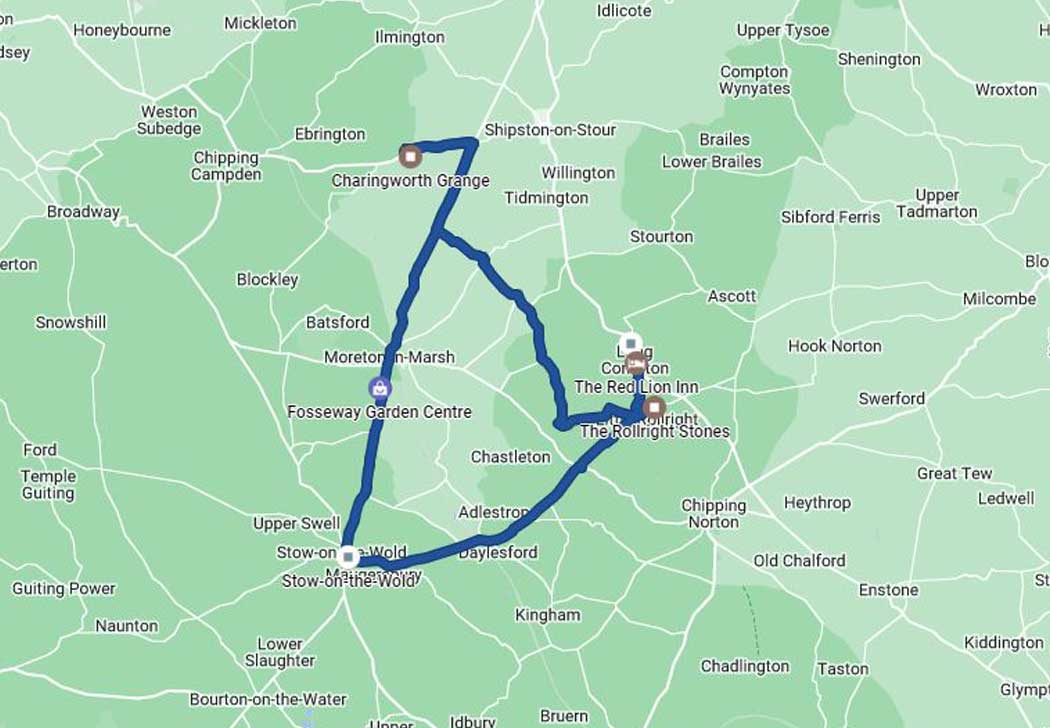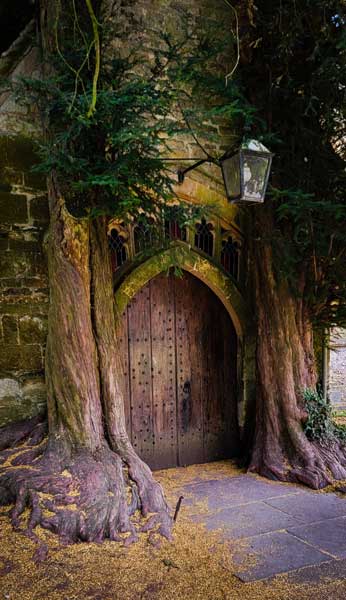England 2022
July 20, 2022 – Day 8 (part 1)
Stones and Witches
Here are all of today’s photos!
See the map for today’s destinations!


Oakleigh House
Casa de Edwards

Rollright Stones
Neolithic stone circle and monuments

Stow-on-the-Wold
Magical-looking door that inspired JRR Tolkien
Let’s travel back in time.
 Seriously… literally travel back in time several thousand years.
Seriously… literally travel back in time several thousand years.
The Rollright Stones are a complex of three Neolithic monuments atop a Cotswold limestone ridge with the village of Long Compton below the ridge (this will be important for a couple of reasons later in this journal!). Historians date the construction of these monuments to time periods between 3000 and 1000 B.C.!!
The three distinct monuments at this site are known now as the King’s Men (seen here in the -not my- drone video screen capture), the Whispering Knights, and the King Stone.
Each are from slightly different timeframes, but given this location – it’s clear that the people who constructed them thought this area of some ritual and/or religious importance!
Earlier this year when I was looking for “new things” for this trip, the Rollright Stones were HIGH on my list of things I wanted to experience. John and Marianne had pre-scouted this location before my travel (ha!) to make sure it would be impressive enough for me.
I love that they wanted to make sure I wouldn’t be disappointed … well, they certainly had nothing to worry about!
.jpg) When we first arrived, the “parking”, as it were, is literally a small pull-off large enough to accommodate maybe a half-dozen vehicles at most. While we weren’t ever completely alone, there wasn’t a crowd of people at any time, so we definitely felt like we had this amazing historical site to ourselves more often than not.
When we first arrived, the “parking”, as it were, is literally a small pull-off large enough to accommodate maybe a half-dozen vehicles at most. While we weren’t ever completely alone, there wasn’t a crowd of people at any time, so we definitely felt like we had this amazing historical site to ourselves more often than not.
Entering the site, a signpost shows you the relative location of each of the three monument sites. The first and largest of the three are the Kings’ Men, a stone circle over 100′ in diameter. These stones are relatively closely spaced and form a rough circle that has a walking path that has been worn into the turf over the millennia.
Legend has it that if you walk the circle, you’ll never count the same number of stones twice (spoiler alert – there are 77 of them).
We heard a fun “tall tale” from John’s mother when we had lunch with her later in the week from when her father (John’s grandfather) was a deliveryman and had a little time to kill before a next stop down in Long Compton.
He pulled over at the Stones and decided to walk the circle and count them – but to mark his starting stone, he put a loaf of bread atop a prominent stone and started counting as he walked. When he returned to that point – the bread was gone, so he was never able to confirm his count (nor did he see who/what stole the bread!).
.jpg) My guess is the Rollright Witch took it!
My guess is the Rollright Witch took it!
There is a more modern folktale (circa 1610… well, it’s certainly more modern than 3000 BC, right?) that goes something like this:
A king riding across the county with his army was accosted by a local witch called Mother Shipton, who said to him:
“Seven long strides thou shalt take, says she
And if Long Compton thou canst see,
King of England thou shalt be!”
His troops gathered in a circle to discuss the challenge, and his knights muttered amongst themselves, but the king boldly took seven steps forward. Rising ground blocked his view of Long Compton in the valley, and the witch cackled:
“As Long Compton thou canst not see,
King of England thou shalt not be!
Rise up stick and stand still stone,
For King of England thou shalt be none;
Thou and thy men hoar stones shall be,
And I myself an elder tree!”
The king became the solitary King Stone, while nearby his soldiers formed a cromlech, or circle, called the King’s Men.
As the witch prepared to become an elder tree, she backtracked into four of the king’s knights, who had lagged behind and were whispering plots against the king. She turned them to stone as well. Today they are called the Whispering Knights.
There’s a wicker replica Rollright Witch standing prominently near the King’s Men.
Of course, she showed up frighteningly “right behind me“.
The King’s Men
.jpg) Those poor soldiers … minding their own business … just following orders … and now… poof. Stone.
Those poor soldiers … minding their own business … just following orders … and now… poof. Stone.
This stone circle, more similar to circles further north in England, is very impressive in its age and scale. While it doesn’t have the height and overall massiveness of Stonehenge, it’s clear to see from not only the layout but also the overall placement that this was a very important ritual location to the ancient people who built it.
The stones themselves are not shaped, particularly – but it is interesting to note that if a stone had a smoother side, it was placed facing the inner part of the ring.
I did walk the ring and try to count (see the sped-up video yourself!) — let’s just say I was “in the neighborhood” of 77 stones and leave it at that. 🙂
The stones are covered in lichen and have a very mystical air to them. There were a couple that actually had holes through the middle, which of course made for excellent photo opportunities!
.jpg) Walking the path inside these stones, several times, I was definitely feeling the history of this site. Knowing that uncountable multitudes have been here before me is a little hard to process. Ancient people who built this through medieval travelers who stumbled across it it through modern tourists who to this day wonder about its meaning… all walking the same ground, looking at the same stone, and perhaps thinking the same thoughts… really an interesting feeling to have.
Walking the path inside these stones, several times, I was definitely feeling the history of this site. Knowing that uncountable multitudes have been here before me is a little hard to process. Ancient people who built this through medieval travelers who stumbled across it it through modern tourists who to this day wonder about its meaning… all walking the same ground, looking at the same stone, and perhaps thinking the same thoughts… really an interesting feeling to have.
John and Marianne had brought a blanket, some snacks for Henry, and other diversions so that I could have whatever time I wanted here. Well, of course, I wanted to get a couple of photos of Henry while I was doing “my thing”, and was very much pleased with the results.
On one edge of the ring, closest to some of the surrounding trees, I noticed some colorful ribbons tied to a particular set of branches. On further inspection, these looked like very pagan/naturalist offerings called “clooties” – asking for healing. Sure enough, just into the trees themselves, was a clearing and a small altar/table set up with more of these. Obviously, I didn’t want to disturb any of them, but it was interesting to see people still thought this area has particular spiritual relevance.
One stone, in particular, stood out – as it was significantly taller than the rest. Most of the others topped out around 4-5′ in height, where this one was clearly at least 8-9′ tall. I’ve read that when this ring was first constructed, there were more stones closer together with fewer gaps. That would’ve been absolutely fascinating to see.
The Whispering Knights
About a quarter-mile away from the King’s Men circle is a formation of stones thought to be earlier by about a thousand years than the circle I just left! Thought to be an ancient “portal dolmen” burial chamber with the standing stones supporting a capstone (which now seems to be on the ground in front of the standing stones as I approach), this would’ve been a tomb for a fairly important person at the time – or at least a very impressive structure denoting the spiritual significance of this area.
Once again, I’m “all alone” with both these ancient stones and my thoughts. The strategic placement of the stones – which originally would’ve had a similar structure to the capstones at it’s more famous cousin, Stonehenge – must have been a sight to see. Similar to the massive cathedrals of our more modern times (funny to think of the 12th and 13th century as “more modern”, but here we are), sometimes you just “need to impress” I guess.
Walking around the Knights and thinking about not only how these ancient people moved and lifted these incredibly heavy stones into place, but also about how even now the location has a sense of “other-worldliness”. Set atop a Cotswolds ridge, the rolling hills below and the ever-present breeze brought an oddly noticeable silence to the area. I can only imagine what the feeling would be like in colder months with lower cloud ceilings, random fogs, and other weather events that would easily lead to a more “spooky” ambience!
Happily for me, it was a nice enough (albeit cloudy) day and there were no ghosts (that I saw).
Now – off to visit the King!
The King Stone
.jpg) If only he would’ve taken longer strides, right?
If only he would’ve taken longer strides, right?
Making sure that I looked both ways (multiple times, to make sure I wasn’t going to get hit by forgetting traffic flows on the opposite sides!), I crossed the roadway to visit the King Stone.
Set (as per legend) about half-way up a noticeable slope, this single stone has led to a variety of theories about its original purpose relative to the other Rollright Stones. It seems, and is the least-debunked theory, to be simply a marker stone for the larger burial site that surrounds it.
Atop the ridge that (again, as per legend) overlooks Long Compton below, a Bronze Age barrow contains remains and has marker stones that can still be seen poking out of the grass along the ridgeline. I didn’t learn this until writing this journal – but I’m glad I walked to the ridgeline and got a few photos of these “obviously placed” stones (that were a mystery to me at the time, but now solved!).
Unfortunately, a significant amount of the King Stone has been chipped away over the years by overzealous souvenir hunters leading to its now distinctive shape, until the fences were erected around this and the Whispering Knights in the mid 1880s.
One of the hazards of having so many ancient and easily-accessible sites, I guess.
Fortunately more modern sensibilities have dedicated themselves to preserving and studying them while honoring the past and present significance of such relics.
Again, by myself, it’s a wonderful experience. I’m joined shortly by Marianne who wanted to see the King Stone herself! After some more time, we bid farewell to the King and rejoin John and Henry to pack up and head down to Long Compton!

.jpg)


